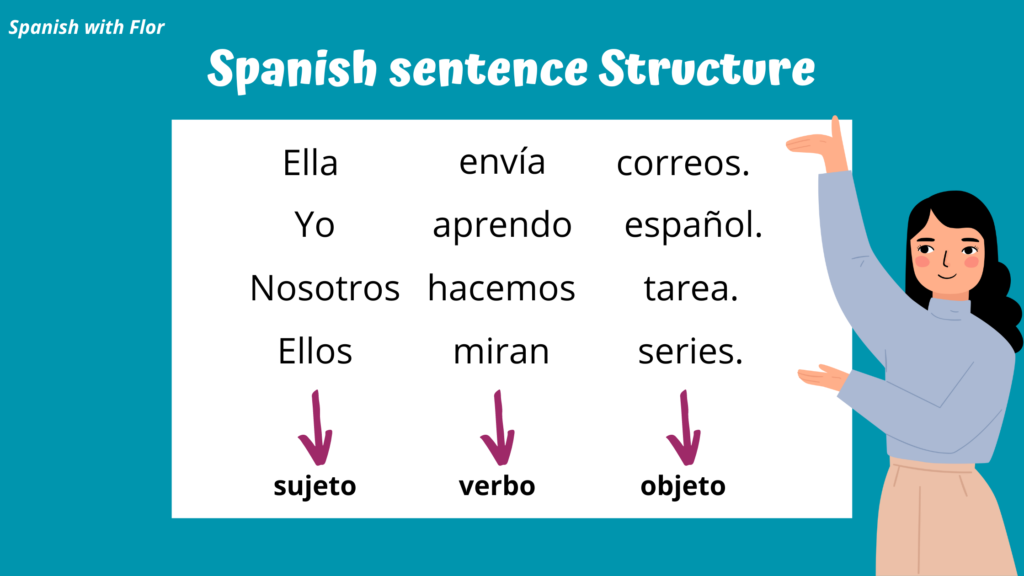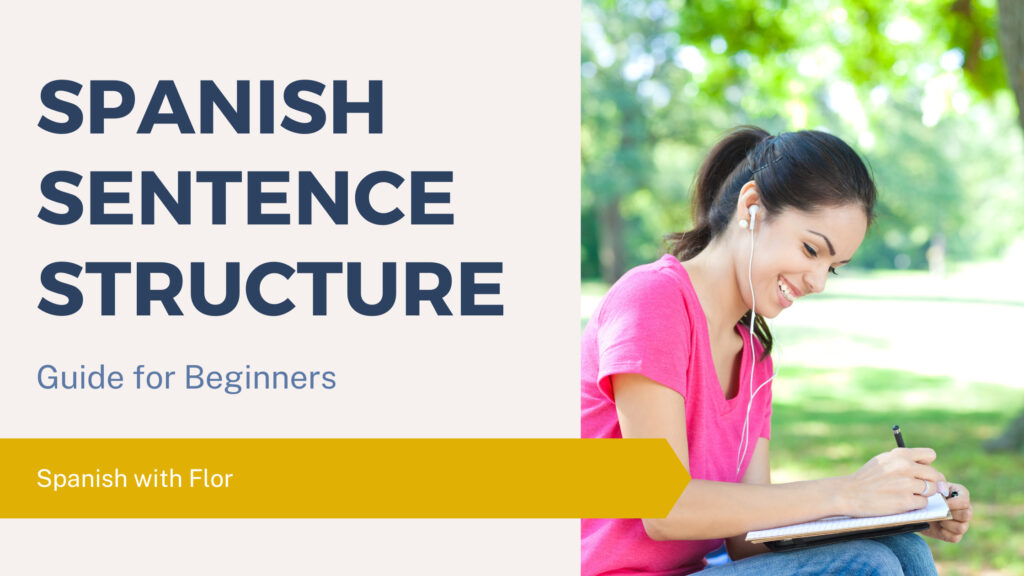One of the first things you need to learn in Spanish is constructing basic Spanish sentences. This involves understanding the proper word order, subject-verb agreement, and the importance of using the correct verb tense.
In Spanish, the basic sentence structure is Subject-Verb-Object (SVO). This means that the subject of the sentence comes first, followed by the verb, and then the object. For example, “Yo como una manzana” (I eat an apple) follows the SVO structure.
The subject and object can be replaced with pronouns, such as “él” (he) or “ella” (she). For example, “Él come una manzana” (He eats an apple) follows the same SVO structure.
Word Order in Spanish
Word order is crucial in Spanish sentence structure, as it can completely change the meaning of a sentence. For example, “Yo envío un correo a mi prima” (I send an email to my cousin) is different from “Un correo me envía” (An email sends me). The first sentence follows the SVO structure, while the second sentence uses the OVS (Object-Verb-Subject) structure.
By understanding the basics of Spanish sentence structure, you’ll be able to construct simple sentences and communicate effectively in Spanish. With practice and patience, you’ll soon be able to expand your vocabulary and tackle more complex grammar concepts.
What are the types of sentences in Spanish?
When it comes to writing sentences in Spanish, it’s important to understand the four types of sentences that exist in the language. Each type of sentence serves a different purpose, and knowing how to use them correctly is essential to effective communication.
Statements & Declarations (Oraciones Enunciativas)
The most common type of sentence in Spanish is the statement or declaration. These sentences simply state a fact or express an opinion. They typically follow a subject-verb-object word order, with the subject coming before the verb and the object coming after it. For example:
- Yo hablo español. (I speak Spanish.)
- Ella come una ensalada. (She eats a salad.)
Questions & Interrogatives (Oraciones Interrogativas)
Questions in Spanish are formed by inverting the subject and verb, or by using a question word such as “qué” (what), “dónde” (where), or “cuándo” (when). There are two types of questions in Spanish: open-ended questions and closed-ended questions. Open-ended questions require a more detailed response, while closed-ended questions can be answered with a simple “yes” or “no”. For example:
- ¿Qué hora es? (What time is it?)
- ¿Dónde está el baño? (Where is the bathroom?)
- ¿Te gusta la música? (Do you like music?)
- ¿Hablas español? (Do you speak Spanish?)
- ¿Por qué estudias español? (Why do you study Spanish?)
Commands, Orders, Imperatives, Directives (Oraciones Imperativas)
Imperative sentences are used to give commands or orders, and they typically use the same verb form as the present tense. However, the subject is usually left out of the sentence, and the verb is often followed by an object pronoun. For example:
- ¡Come la cena! (Eat your dinner!)
- ¡Abre la puerta! (Open the door!)
→ To continue reading: Commands in Spanish Grammar: Uses, Conjugation, and Examples
Exclamations (Oraciones Exclamativas)
Exclamatory sentences are used to express strong emotions such as surprise, excitement, or anger. They typically begin with an interjection such as “¡Qué!” (What) or “¡Cómo!” (How), followed by the subject and verb. For example:
- ¡Qué bonito es el paisaje! (How beautiful the landscape is!)
- ¡Cómo me gusta el helado! (How much I love ice cream!)
Wish (Oraciones Desiderativas)
Desiderative sentences are used to express a wish or desire. They typically begin with the word “ojalá” (I hope), followed by the subjunctive form of the verb. For example:
- ¡Ojalá que llueva hoy! (I hope it rains today!)
→ To learn more about expressing wishes in Spanish: What is the Present Subjunctive in Spanish Grammar
Learning Common Spanish Phrases
Finally, it’s important to learn common Spanish phrases that can be used in a variety of situations. These phrases can help you communicate more effectively and make it easier to navigate everyday conversations in Spanish. Some common phrases include:
- Hola, ¿cómo estás? (Hello, how are you?)
- ¿Me puedes ayudar? (Can you help me?)
- Gracias por tu ayuda. (Thank you for your help.)
How do you write sentences in Spanish for beginners?
If you’re just starting to learn Spanish, it’s important to understand the basic structure of a sentence. Spanish sentences are structured similarly to English sentences, with a subject, verb, and object. However, there are some differences in word order and grammar that you’ll need to be aware of.
What is the formula for writing a sentence in Spanish?
In Spanish, the basic formula for a sentence is subject + verb + object. For example, “Yo como una manzana” (I eat an apple) or “El perro corre en el parque” (The dog runs in the park).

One thing to note is that Spanish is a gendered language, so the gender of the subject and object must match. For example, “El gato atrapa un ratón” (The cat catches a mouse) uses the masculine article “el” for “gato” (cat) and the masculine noun “ratón” (mouse).
How do you structure a Spanish question?
To form a question in Spanish, you can use the same formula as a statement, but with a question mark at the end. For example, “¿Tú hablas español?” (Do you speak Spanish?) or “¿Dónde está el baño?” (Where is the bathroom?).
Another way to form a question is to invert the subject and verb. For example, “¿Hablas español?” (Do you speak Spanish?) or “¿Está el baño aquí?” (Is the bathroom here?).
How do you turn a Spanish statement into a question?
To turn a statement into a question, you can add the word “¿verdad?” (right?) at the end. For example, “Tú hablas español, ¿verdad?” (You speak Spanish, right?) or “Ustedes toman clases de español en línea, ¿cierto?” (You take Spanish lessons online, right?)
How do you make a Spanish sentence negative?
To make a sentence negative in Spanish, you can add the word “no” before the verb. For example, “No hablo español” (I don’t speak Spanish) or “Ellas no están en casa” (They are not at home).
It’s important to note that in Spanish, the word “no” can also be used to answer a yes or no question negatively. For example, “¿Hablas español?” (Do you speak Spanish?) “No” (No, I don’t). Or “¿Te gusta la comida mexicana?” (Do you like Mexican food?) “No, no me gusta” (No, I don’t like it).
Practice Writing Exercises
Once you have a good grasp of basic Spanish sentence structure, it’s time to start practicing writing exercises to reinforce what you’ve learned. Here are some tips and resources to help you practice your sentence writing skills:
Practice Sentence Writing
There are many resources available online to help you practice sentence writing in Spanish. Here are a few options to consider:
- Online Spanish classes: Many online Spanish classes include writing exercises as part of their curriculum.
- Reading: Reading Spanish texts can help you practice identifying sentence structures and understanding how they work in context.
- Basic sentence practice: Websites like SpanishDict.com offer basic sentence practice exercises to help you reinforce what you’ve learned.
- Spanish sentence structure diagram: Diagramming sentences can be a helpful way to visualize sentence structure and identify any areas where you need to improve.
- Spanish sentence generator: Some websites offer sentence generators that can help you practice writing sentences in Spanish.
By practicing writing exercises and using resources like cheat sheets and sentence generators, you can improve your Spanish writing skills and build more complex sentences over time.
Advanced Sentence Structures
Once you’ve mastered basic sentence structure, you can start practicing more advanced sentence structures. This will help you build more complex sentences and express more nuanced ideas. Here are some examples of advanced sentence structures:
- Conditional sentences: “Si tuviera más tiempo, iría al cine.” (If I had more time, I would go to the movies.)
- Subjunctive sentences: “Es importante que estudies para el examen.” (It’s important that you study for the exam.)
- Compound sentences: “Me gusta la música y el arte.” (I like music and art.)
- Complex sentences: “Aunque no me gusta el frío, me encanta el invierno.” (Although I don’t like the cold, I love winter.)
If you are looking to start your Spanish learning, I can help you!
Join the Spanish with Flor Basic Spanish Course where I will teach you all the basics to kickstart your Spanish!


